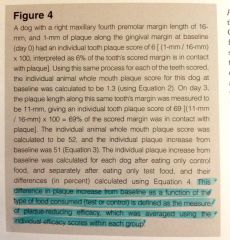![]()
![]()
![]()
Use LEFT and RIGHT arrow keys to navigate between flashcards;
Use UP and DOWN arrow keys to flip the card;
H to show hint;
A reads text to speech;
16 Cards in this Set
- Front
- Back
|
This research was directed toward the development and validation of a new substrate scoring system that reduces resources while maintaining or increasing the reproducibility attributed to the more traditional methods
|
This new gingival contour plaque index was shown to be accurate and reproducible, but used fewer animals, required less time, and eliminated the need for many of the specialized procedures required by traditional methods
|
|
|
Dental calculus & gingivitis ranked first and second, respectively in prevalence for dogs and cats examined at private vet practices
|
The desire to reduce the formation of plaque and calculus is intimately associated with the need to accurately and reproducibly quantify their levels
|
|
|
The aim of the research reported here was to develop and validate the gingival contour plaque index (GCPI) as a new substrate scoring system that might reduce resources while maintaining or increasing accuracy and reproducibility
|
Modifications were made to the modified gingival margin plaque index (MGMPI) model of plaque quantifications that accommodate the inherent differences in the dentition and temperment b/w humans and dogs
|
|
|
The GCPI model quantifies plaque that is in contact with the buccal surface of the gingival margin as a fxn of its length
|
Measurements of the length of the gingival margin and of the plaque that is in contact with the gingival margin are made using a newly designed gingival contour probe
|
|

The probe is like a ruler and is designed with a 3-D bend and markings every 2-mm in order to more easily follow the curvature of the gingival margin, and the margin length is read from the scale to the nearest 1-mm
GINGIVAL CONTOUR PROBE |
Measurements are made from the midpoint of the mesial surface, along the buccal surface, to the midpoint of the distal surface, at the point where the gingival margin contacts the tooth
|
|
|
All quantification procedures were performed on conscious animals with atropine given SQ, to temporarily reduce saliva flow that may obscure and distort the grader's view of the oral surfaces
|
Plaque was allowed to accumulate for 3-days for each food tested as a standard procedure
|
|
|
Individual tooth plaque scores were calculated for each tooth as a percent of the length of the gingival margin of each tooth
|
Individual tooth plaque score=
(length of plaque along margin/margin length) X 100 |
|
|
The individual tooth plaque scores were then averaged to obtain an individual animal's whole mouth score
|
Whole mouth plaque score=
avg. of ind'l tooth plaque scores |
|
|
Individual whole mouth plaque score was then used to calculate the plaque increase from baseline for each animal
|
Plaque increase=
whole mouth plaque score after accumulation - whole mouth plaque score at baseline |
|
|
Finally, the plaque-reducing efficacy of the test food was calculated as a percentage of the difference in the individual plaque increase from baseline of the test vs. control foods
|
Efficacy=
(plaque increase of control - plaque increase of test/ plaque increase of the control) X 100 |
|

The GCPI method of plaque quantification is independent of feeding order
|
True
|
|
|
A new method was developed that allows accurate and reproducible quantification of plaque accumulation, concomitant with a reduction in human and animal resources
|
A summary of the data from all studies run during the validation process suggests that a crossover design using 2 or 3 days for plaque accumulation produces consistent results with acceptable variability
|
|
|
Studies requiring increased sensitivity can be accomplished by increasing the number of subjects by only a few animals
|
This validation process also demonstrated that the results generated using the GCPI method are independent of grader identity, panel identity, and feeding order
|
|
|
The GCPI validation studies were able to establish statistically significant differences in the plaque-reducing efficacy of foods using only 5 dogs
|
This method only required 3 people for optimal performance; a grader, a recorder, and a handler
|
|
|
Important to note--that there was no expectation of a high degree of correlation b/w these methods, nor is one required for method validation
with the similar results found with GCPI and Logan/Boyce plaque quantification method |
GCPI method evaluates plaque accumulation only at the gingival margin where clinical relevance is well documented
|
|
|
The GCPI method was shown to be a quick, accurate, reproducible, and less resource intensive method for quantifying plaque and evaluating the efficacy of plaque reducing technologies in dogs compared with traditional methods
|
GCPI is well suited to implementation in field trials
|

